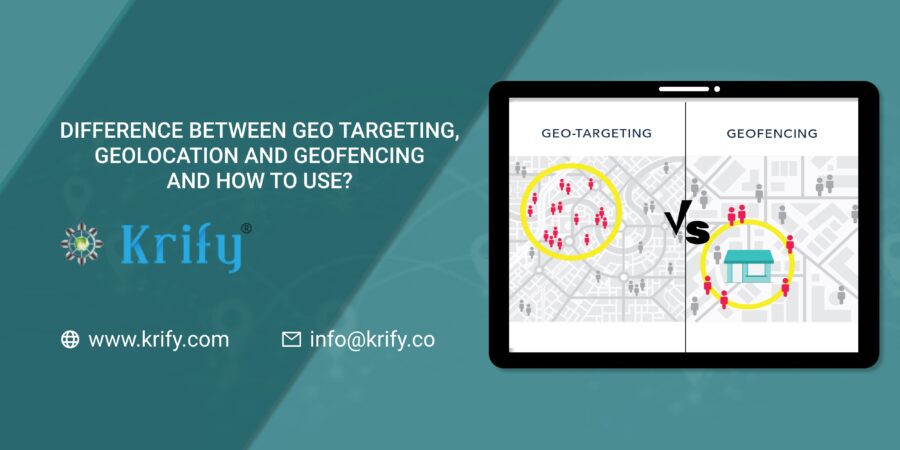Difference between Geofencing, Geo-location, and Geotargeting and how to use it?
With the ever-growing use of smartphones rather than just a telephone call, organizations are cautious about bringing their products and services to their clients. And firms can do precisely that with geolocation technology. Location-based marketing is the technology-based technique using current user geolocation and trip history to enhance ‘brand client’ communication.
Marketing is more customizable to the client and their actual position and demands using geofencing and geo-targeting. While the words “geofencing” and “geotargeting” commonly implement each other interchangeably, there are different marketing tactics. Understanding the distinction between geofencing and geotargeting will help you choose intelligent marketing that will lead to a growing firm.
What is Geofencing?
Geofencing is the placing of a virtual boundary on a map view. It provides an area for transformation which tracks the entry and exit from the specific mobile devices, usually the mobile devices integrated in the organization’s application. When the device of the user approaches and leaves the conversion zone, a default action is triggered. It can be a notification through text.
What is Geolocation?
Geolocation is used to locate and track connected electronic devices through localized technologies like GPS or IP addresses. Since these gadgets are typically placed mostly on individuals, geolocation is widely utilized for monitoring people’s movements and locations.
What is Geotargeting?
Geo-targeting means adverts for those that fulfill specified targeting parameters and enter the same geo-fencing system into a predetermined radius. The main distinction is the geo-targeting of certain consumer factors such as demographics, actions, preferences, and individual stand.
Difference between Geofencing, Geolocation, and Geotargeting
-In order to produce geofences, customers utilize geofencing applications or software. And when a locational device crosses a zone, geofences are triggered. Depending on the demands of the designer, a geofenced area may be quite large or just very small. A user might, for example, locate a space, a layout, or a whole city.
-The use of geofencing for marketing is a result of geotargeting. Geo-targeting, often known as local marketing, uses geofencing for geographically targeted consumers. For instance, a used library can set the geofence for regional customers near a bookstore and promote them to buy locally.
-Geolocation is an object’s geographical location in real-time, usually a mobile device or a digital device. If you have a vehicle with GPS tracking or smartphones, you are using geotargeting items. For directions, delivery of meals, social media check-in, weather predictions, and more, geolocation is used.

Application of Geofencing
Here are a few more common geofencing applications.
1.Safety: If children get alerts in real-time as they come and go from certain places. Pet caretakers may make virtual connections for their pets using applications such as Wagz and receive notifications when their pets leave the yard. Apps such as MindMe warns caretakers not to leave a “safe zone” for patients or family and friends or enter prohibited areas.
2.Time tracking: Time tracking geofencing requires employees to clock in or leave a geo-fenced workplace. When staff comes to visit, managers can see employee’s activities from an on-site distance.
3.Vehicle tracking: Unauthorized usage of cars, fuel expenses, and more can be limited by geofences tracking of fleet activities.
Application of Geotargeting
1.Geotargeting could be used by a department store to push a coupon or notify customers taking part in a local purchase.
2.A cafeteria near a university may utilize geotargeting to advertise job offerings for campus students.
3.The footwear store can use the targeting to notify people attending music concerts about the upcoming discount.
Application of Geolocation
To understand the application of geolocation, we have listed few mobile apps that use designer’s demands for geolocation technology.
- Target: By applying for discounts and buying everything, you can shop and select your items. Then, when your present position shows you are close, a Target Partner will rush out and load your goods.
- Waze: The Waze app enables drivers to report accidents, buildings, and even speed traps linked into live maps in real-time, allowing commuters to pick other routes on the fly.
- Scavify: Scavify uses geolocation data and location sharing to automate a beneficial activity that most typically paid event planners for organizing with social and business interests.
Conclusion:
Every technology has its importance, and it depends on the user’s requirement to choose the right one and the appropriate one that fulfills their idea.
At Krify, we have a team of professionals who are well versed in the latest trends and technologies, passionate about developing robust mobile and web applications. Suppose you are looking to develop an application with Geofencing or Geotargeting or Geolocation technology. In that case, you are on the right page, as we have assisted the most renowned company Toyota with Geofencing technology for one of their application, based on their requirements shared. For more information, contact us.


